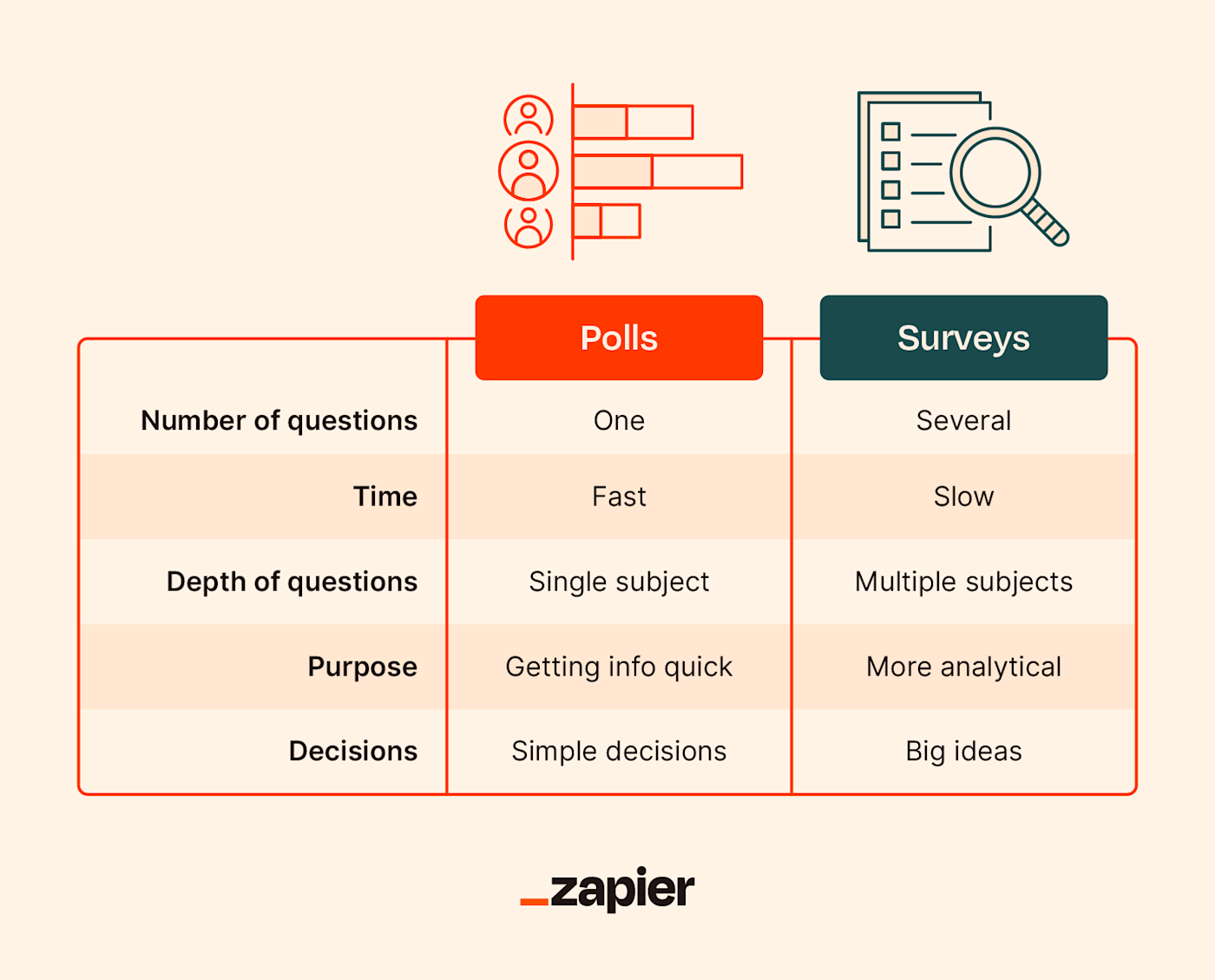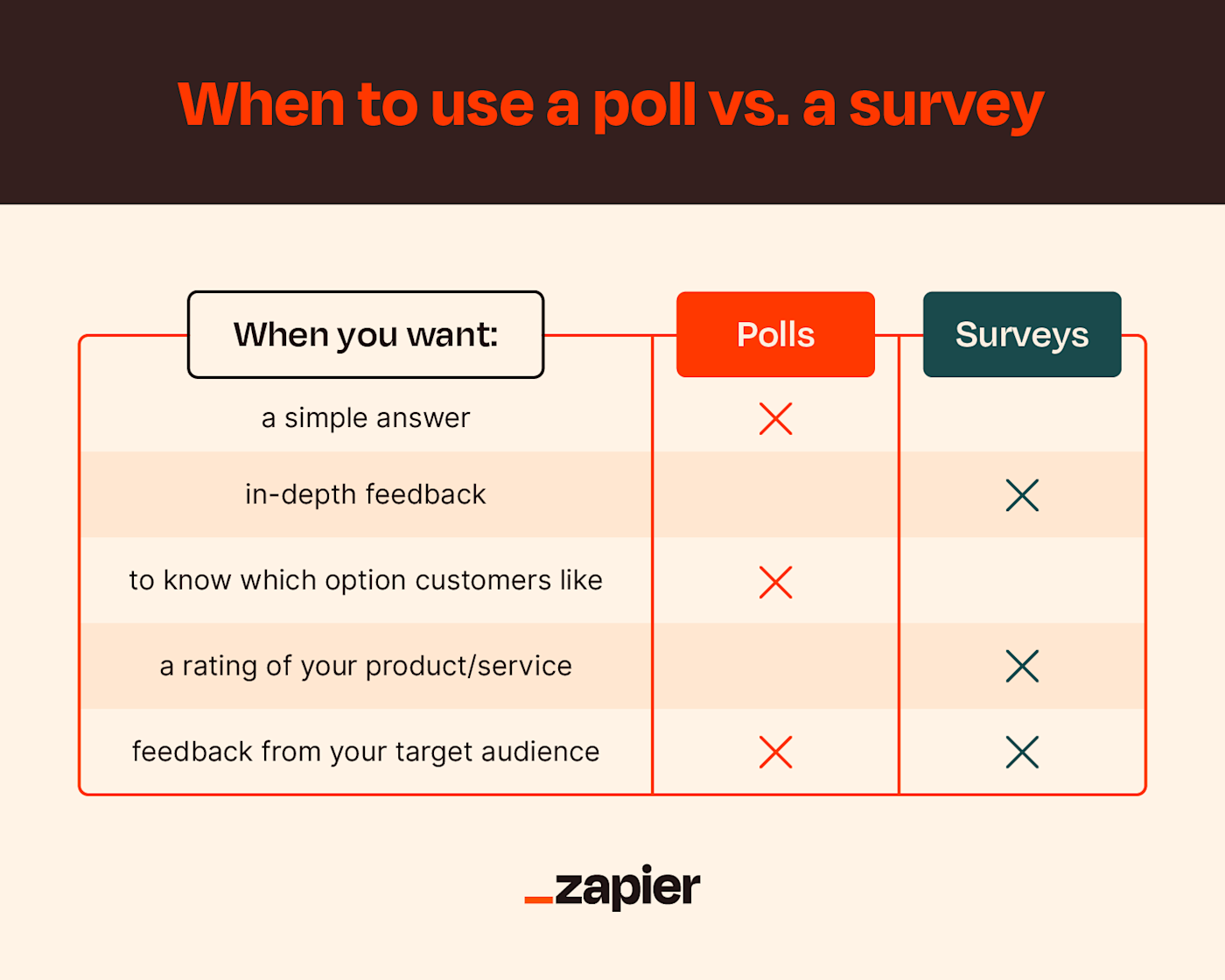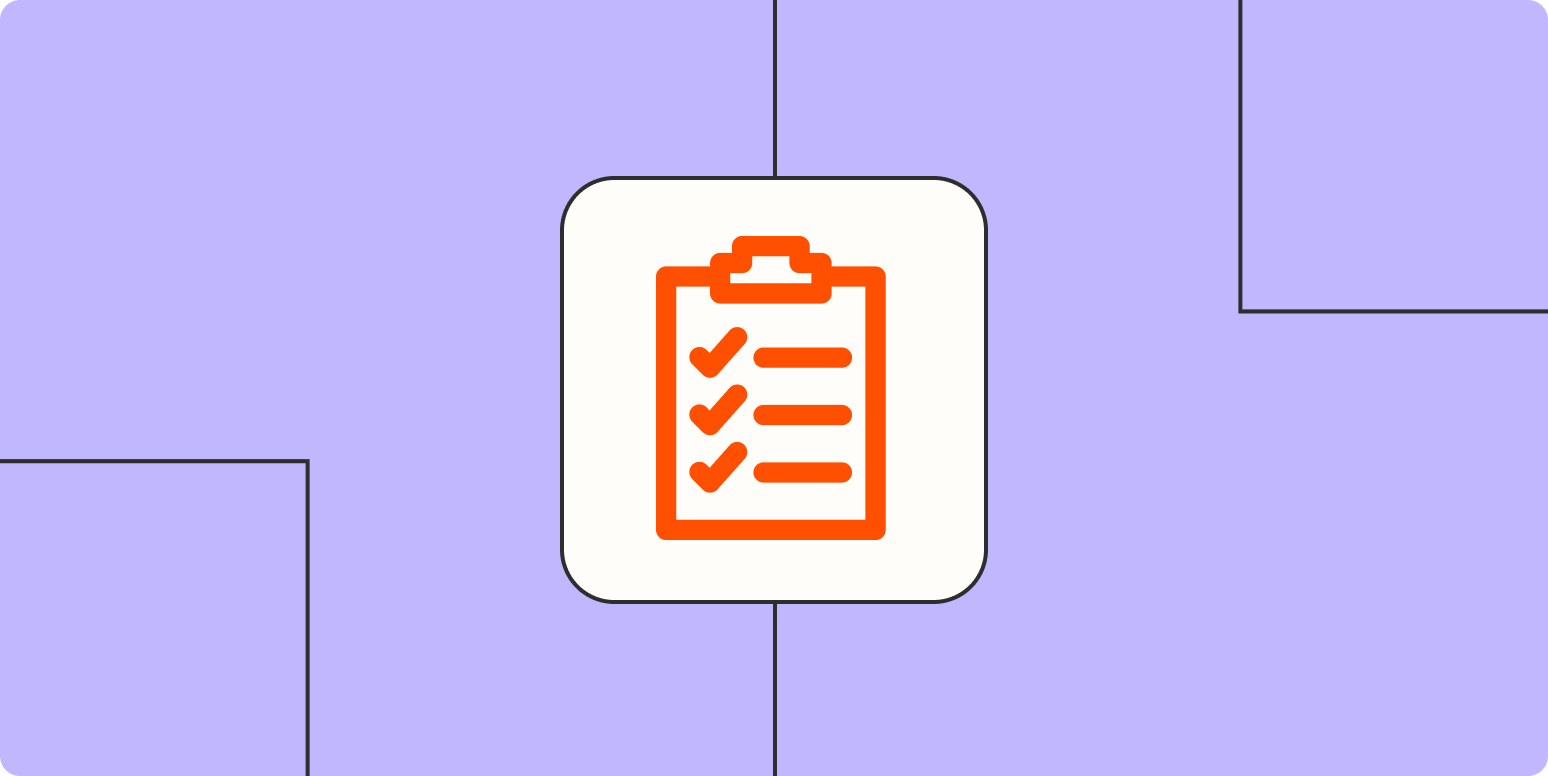You could spend all the money in the world on marketing and still wouldn’t be able to do one thing: read your audience’s mind. Polls and surveys are a gold mine for learning what your audience wants and gaining other valuable information.
But there are clear differences between polls and surveys. If you understand those differences and learn how to structure them, you’ll be well on your way to understanding your audience.
Poll vs. survey: What’s the difference?
The difference between polls and surveys mostly comes down to length: a poll focuses on one question, and a survey asks multiple questions. But of course, there’s a bit more nuance to it than that.

What is a poll?
A poll is a simple tool: you ask a single question to get your target audience’s opinion. Polls are for quick yes or no answers or for giving people a choice between two or three options. You’ll recognize polls from social media apps like Instagram and Twitter, where polls are baked into the functionality.
In honor of @Starbucks dropping their Fall drink menu tomorrow, we have a question…
Is it too early for PSL (pumpkin spice latte)? 🎃☕️
— Zapier (@zapier) August 29, 2022
Polls can be a great way to have fun with your marketing. For example, if I were brave enough to let my audience decide how I should do my hair, I could run a poll that asks, “What should I do to my hair?” Then, I’d give them a few options like:
-
Dye it
-
Cut it short
-
Shave it off
-
Leave it the same
-
Don’t care
For more serious purposes, polls should be used if you want a specific answer to a question. As an example: if you’re trying to develop a strategy around a promotion and want to ask your website visitors which products they’re most interested in, a poll would work great.
How to run an effective poll
The main problem with polls is that they aren’t all that nuanced. But that doesn’t mean you can’t get the information you need from them. Here are some tips:
-
Only ask closed-ended questions: Closed-ended questions give you quantitative data, and open-ended questions create a mess when you’re doing a poll—save those for surveys.
-
Keep poll questions short and simple: A poll question should be one sentence. If necessary, add an intro sentence for some context to the question you’re asking.
-
Limit options: Your poll should ideally have two or three options, but you can stretch it to five. If you want to get more detail than that, it may be time to use a survey.
-
Have a “don’t know”/”does not apply” option: Some polls warrant a simple yes or no, but you should also have a “not applicable” option or something similar. If you don’t have that option, you may be forcing an answer. For example, if you ask, “Do you like apples or oranges better?” you may want the options to reflect more than just one or the other—it’d be valuable to know if people simply don’t like fruit.
-
Only ask one question: For the love of all things good in this world, your one question needs to be one question. It’s tempting to cram multiple questions into one question, like “Did you enjoy the product and customer service?” But what if the product was great but the customer service was awful, or vice versa? Split these into multiple questions, and create a survey if you need that much information.

Once you have your question and answer options built out, you just need to get the poll out into the world. If you don’t want to run your poll on social media, there are plenty of online poll apps to choose from.
What is a survey?
A survey is a series of questions (or sometimes just one question) that helps you gather more nuanced answers. It gives you more data to analyze and can provide you with deeper insights than a poll.
-
Instead of knowing if people liked something, you can find out how much they liked it.
-
You’re able to include short answer questions, which can help you get information you wouldn’t have known to ask about.
-
You can ask a series of questions to help get more nuanced feedback on a topic.
-
You can use branching and logic to customize the survey experience.
Forms vs. surveys
The difference between surveys and forms is a little subtler. In the simplest sense, forms collect specific data, while surveys are more suited for collecting nuanced feedback or opinions. For example, you’d use a form to collect purchase orders, event registrations, and email subscribers.
To better understand the difference, take a look at Zapier’s list of the best form-building apps, which is different from their list of the best survey apps—though there is some overlap because many tools can absolutely do both.
Types of surveys
Surveys are a great way to get data from your coworkers and employees. You can also use them to gain valuable information from current and prospective customers. Here are some examples:
-
Employee experience surveys: Understand how new hires feel about the onboarding and training process, learn what employees think of management, find out what employees would like to see for incentive programs—you name it.
-
Net Promoter Score (NPS): The goal of NPS surveys is to figure out how likely people are to recommend you to others. This survey asks, “On a scale of 1 to 10, how likely are you to recommend us?” with one follow-up question.
-
Customer Effort Score (CES): This survey helps you understand if your customers have a hard time with your product or service and has questions like “On a scale from 1 to 10, how easy was it to use our product?”
-
Customer Satisfaction Score (CSAT): This is similar to a CES survey but about satisfaction instead of effort.
-
Market research surveys: A market research survey is a questionnaire designed to collect key information about a company’s target market and audience that will help guide business decisions about products and services, branding angles, and advertising campaigns.
Of course, these are just standard survey styles—there are no real restrictions to the type of survey you do. You may want to try combining these types if you’re looking to gather a lot of information and one style doesn’t fit the purpose of your survey.
How to run a quality survey
The main issue with surveys is that they’re time-consuming for both you and the people filling them out. You really need people who care about your efforts in order for them to actually want to sit down and take the time to complete your survey. Here are some tips to help:
-
Rely on loyal customers: The sky’s the limit when adding survey questions, but you need an extremely loyal customer base if you make it lengthy, or they’re not going to complete it. The great thing is that loyal customers are happy to do surveys because it makes them feel part of the process.
-
Don’t forget about prospects: Loyal customers are a great segment to focus on, but you also want feedback from people who are new or even unfamiliar with your brand. This group often contains people who have awareness but haven’t purchased yet.
-
Tell respondents what to expect. Nobody likes starting a survey and then realizing it’s going to take a lot longer than they were planning. Being transparent about how long it will take will not only increase the likelihood of them finishing the survey, but will also make them more likely to do your next one.
-
Use the right question types. Most surveys will include a variety of question types, including yes/no, multiple choice, dropdown, ranking, short answer, and more. Be sure you’re using the right question type for the right question, and consult best practices for developing an effective survey.
-
Lean on your survey app for help. The best survey apps will have sample questions for you to use based on the type of survey you’re creating, and many will even have entire survey templates. Lots of research has been put into creating these, so don’t feel like you have to reinvent the wheel every time.
-
Always have a short-answer section: Each survey should have a short-answer section. This gives respondents the ability to give you answers to questions that you may not have asked as additional feedback. You don’t know what you don’t know, and unlike with polls, you can find out. Even if it’s the last question on the survey, let people add anything you might have missed.
-
Use branching and logic. Create “if-then” functions within your survey. For example, if the person answers “yes” to this question, then they receive option 1 as the next question, or if they answer “no,” then they receive option 2. You wouldn’t want a person to answer “No, I’ve never used this product,” and then continue answering questions about it.
-
Survey a representative sample: If you can’t create a representative sample of your target audience of customers or prospective customers, you need to include additional questions. For example, include demographic questions in your survey so you can categorize the data once the survey is complete.

Automate your polls and surveys
Once you set up your poll or survey, you can use automation to feed responses directly into a platform of your choosing, so you can easily comb through it without having to organize it yourself. Automatically send responses to your CRM, database, spreadsheet, or wherever else you store things. Learn more about how to automate your forms and surveys.
[adsanity_group align=’alignnone’ num_ads=1 num_columns=1 group_ids=’15192′]
Need Any Technology Assistance? Call Pursho @ 0731-6725516




